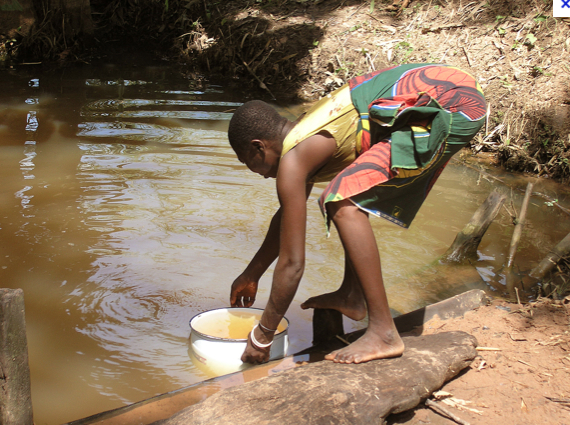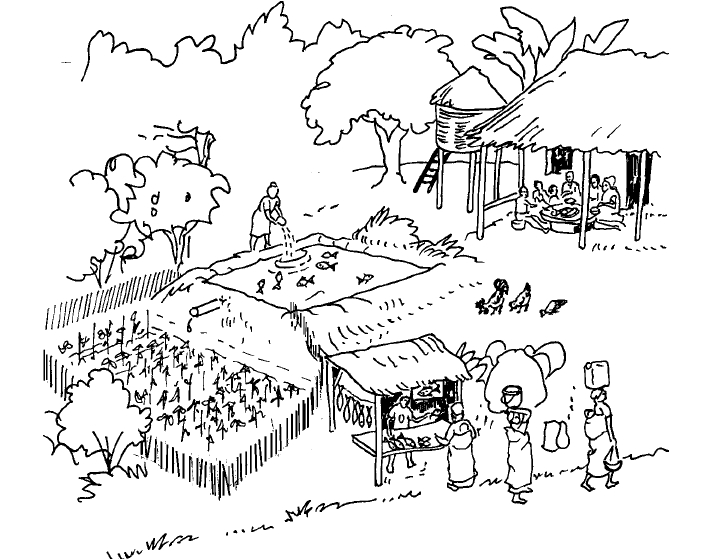Difference between revisions of "Ponds"
(→Construction, operations and maintenance) |
|||
| (6 intermediate revisions by the same user not shown) | |||
| Line 1: | Line 1: | ||
[[Image:storage pond.jpg|thumb|right|300px|This Nigerian woman is gathering water from a local pond, which is used as a source of drinking water. But because of a Guinea worm larvae infestation, this water must be filtered to remove the water fleas that carry the parasitic larvae of the Guinea worm. Photo by E. Staub, courtesy of the CDC and The Carter Center.]] | [[Image:storage pond.jpg|thumb|right|300px|This Nigerian woman is gathering water from a local pond, which is used as a source of drinking water. But because of a Guinea worm larvae infestation, this water must be filtered to remove the water fleas that carry the parasitic larvae of the Guinea worm. Photo by E. Staub, courtesy of the CDC and The Carter Center.]] | ||
| − | Natural ponds provide a good water resource for both domestic and agricultural water supply. | + | Natural ponds provide a good water resource for both domestic and agricultural water supply. However, some ponds are used for waste disposal and sewage, therefore remediation would be necessary before considering to use it for fresh water or agricultural use. |
| − | + | Aquaculture (also referred to as farm ponds) is also an excellent use of ponds to provide both food security and economic security, as the fish can be sold. Farm ponds can provide for a number of benefits that can help smallholders in their quest for development. They provide for water storage for crops, can be used to rear fish and other aquatic organisms like crustaceans, molluscs and plants, be integrated with other farm enterprises and improve and vary farm family diets. | |
| + | |||
| + | ==Suitable conditions== | ||
| + | The type of pond you need to build depends on the land contours (topography). Different types of ponds are suitable for flat and hilly areas. '''Excavated ponds''' are built in flat areas by digging out an area as big as needed for the pond. The water level will be below the original ground level. '''Contour ponds''' are built in hilly areas on a slope. The soil on the upper side of the pond is dug out and used to build up a dam on the lower side. The dam must be strong because the water level in the pond will | ||
| + | be above the original ground level. | ||
| + | |||
| + | ==Construction, operations and maintenance== | ||
| + | [[Image:fish farming pond.jpg|thumb|right|300px|Advantages of fish farming include food and economic security, and crop watering from runoff. Drawing: [http://www.google.com/url?sa=t&rct=j&q=&esrc=s&source=web&cd=19&ved=0CGkQFjAIOAo&url=http%3A%2F%2Fjourneytoforever.org%2Ffarm_library%2FAD15.pdf&ei=VBTAT8qiGuOsiALf_sX4Bw&usg=AFQjCNFVduvo_R82hs4Un2B-KjLg34oMzA&sig2=UqhRFw01IlMHiPZQDAZbuA Small-scale freshwater fish farming.]]] | ||
| + | |||
| + | Depending on the site, there are two different types of fish ponds to choose from: diversion or barrage ponds. | ||
| + | |||
| + | ====Diversion ponds==== | ||
| + | Diversion ponds are constructed by bringing water from another source to the pond. | ||
| + | |||
| + | '''Below are the different types of diversion ponds:'''<br> | ||
| + | A. Embankment ponds: The dikes of an embankment pond are built above ground level. A disadvantage of this type of pond is that you may need a pump to fill the pond. | ||
| + | |||
| + | B. Excavated ponds: An excavated pond is dug out of the soil. The disadvantage of this type is that you need a pump to drain the pond. | ||
| + | |||
| + | C. Contour ponds: Soil from digging out the pond is used to build the low dikes of the pond. The ideal site has a slight slope (1-2%) so the water supply channel can be constructed slightly above and the discharge channel slightly below the pond water level. Since natural gravity is used to fill and drain the ponds, no pump is needed. | ||
| + | |||
| + | ====Barrage ponds==== | ||
| + | Barrage ponds are constructed by building a dike across a natural stream. The ponds are therefore like small conservation dams with the advantage that they are easy to construct. However, it is very difficult to control this system: it is difficult to keep wild fish out and a lot of feed added to the pond will be lost because of the current. A properly built barrage pond overflows only under unusual circumstances. | ||
| + | |||
| + | ====Size and Shape==== | ||
| + | Square and rectangular shaped ponds are easiest to build, but your pond can have a different shape to fit the size and shape of the land. An area of 300 m² is a good size for a family pond, which you can build without the use of machinery. Ponds can be much larger than this, but for family use it is better to have several small ponds rather than one large one. Also, if you have more than one pond you will be able to harvest fish more often. | ||
| + | |||
| + | ====Depth==== | ||
| + | The water depth is usually 30 cm at the shallow end and 1 metre at thedeep end (figure 6). The pond can be deeper than this if the pond is used as a water reservoir in the dry season. It is important that the water can be completely drained for harvesting. | ||
==Field experiences== | ==Field experiences== | ||
| Line 14: | Line 42: | ||
* Miller, James W. [http://www.google.com/url?sa=t&rct=j&q=&esrc=s&source=web&cd=2&ved=0CFcQFjAB&url=ftp%3A%2F%2Fftp.fao.org%2Fdocrep%2Ffao%2F011%2Fi0528e%2Fi0528e.pdf&ei=iQfAT-i8D9TXiQLalJGJCA&usg=AFQjCNEn3AC53Uq5p4SVMiaE_qfsaUlpoQ&sig2=v2usfAZS-hhD1HJPTVuHLQ Farm ponds for water, fish and livelihoods.] FAO, 2009. | * Miller, James W. [http://www.google.com/url?sa=t&rct=j&q=&esrc=s&source=web&cd=2&ved=0CFcQFjAB&url=ftp%3A%2F%2Fftp.fao.org%2Fdocrep%2Ffao%2F011%2Fi0528e%2Fi0528e.pdf&ei=iQfAT-i8D9TXiQLalJGJCA&usg=AFQjCNEn3AC53Uq5p4SVMiaE_qfsaUlpoQ&sig2=v2usfAZS-hhD1HJPTVuHLQ Farm ponds for water, fish and livelihoods.] FAO, 2009. | ||
* [http://www.google.com/url?sa=t&rct=j&q=&esrc=s&source=web&cd=17&ved=0CJABEBYwBjgK&url=http%3A%2F%2Fwww.wateraid.org%2Fdocuments%2Fclimate_change_and_water_resources_1.pdf&ei=RQ_AT5L3DemeiQKbm_XfBw&usg=AFQjCNHMnk2xbsaMwEcfHI5EQW6ieOqFfA&sig2=YjBcjpmnpxAZefKNLN4fEw Climate Change and Water Resources.] | * [http://www.google.com/url?sa=t&rct=j&q=&esrc=s&source=web&cd=17&ved=0CJABEBYwBjgK&url=http%3A%2F%2Fwww.wateraid.org%2Fdocuments%2Fclimate_change_and_water_resources_1.pdf&ei=RQ_AT5L3DemeiQKbm_XfBw&usg=AFQjCNHMnk2xbsaMwEcfHI5EQW6ieOqFfA&sig2=YjBcjpmnpxAZefKNLN4fEw Climate Change and Water Resources.] | ||
| + | * [http://www.google.com/url?sa=t&rct=j&q=&esrc=s&source=web&cd=19&ved=0CGkQFjAIOAo&url=http%3A%2F%2Fjourneytoforever.org%2Ffarm_library%2FAD15.pdf&ei=VBTAT8qiGuOsiALf_sX4Bw&usg=AFQjCNFVduvo_R82hs4Un2B-KjLg34oMzA&sig2=UqhRFw01IlMHiPZQDAZbuA Small-scale freshwater fish farming.] © Agromisa Foundation and CTA, Wageningen, 2008. | ||
Latest revision as of 00:37, 26 May 2012

Natural ponds provide a good water resource for both domestic and agricultural water supply. However, some ponds are used for waste disposal and sewage, therefore remediation would be necessary before considering to use it for fresh water or agricultural use.
Aquaculture (also referred to as farm ponds) is also an excellent use of ponds to provide both food security and economic security, as the fish can be sold. Farm ponds can provide for a number of benefits that can help smallholders in their quest for development. They provide for water storage for crops, can be used to rear fish and other aquatic organisms like crustaceans, molluscs and plants, be integrated with other farm enterprises and improve and vary farm family diets.
Contents
Suitable conditions
The type of pond you need to build depends on the land contours (topography). Different types of ponds are suitable for flat and hilly areas. Excavated ponds are built in flat areas by digging out an area as big as needed for the pond. The water level will be below the original ground level. Contour ponds are built in hilly areas on a slope. The soil on the upper side of the pond is dug out and used to build up a dam on the lower side. The dam must be strong because the water level in the pond will be above the original ground level.
Construction, operations and maintenance

Depending on the site, there are two different types of fish ponds to choose from: diversion or barrage ponds.
Diversion ponds
Diversion ponds are constructed by bringing water from another source to the pond.
Below are the different types of diversion ponds:
A. Embankment ponds: The dikes of an embankment pond are built above ground level. A disadvantage of this type of pond is that you may need a pump to fill the pond.
B. Excavated ponds: An excavated pond is dug out of the soil. The disadvantage of this type is that you need a pump to drain the pond.
C. Contour ponds: Soil from digging out the pond is used to build the low dikes of the pond. The ideal site has a slight slope (1-2%) so the water supply channel can be constructed slightly above and the discharge channel slightly below the pond water level. Since natural gravity is used to fill and drain the ponds, no pump is needed.
Barrage ponds
Barrage ponds are constructed by building a dike across a natural stream. The ponds are therefore like small conservation dams with the advantage that they are easy to construct. However, it is very difficult to control this system: it is difficult to keep wild fish out and a lot of feed added to the pond will be lost because of the current. A properly built barrage pond overflows only under unusual circumstances.
Size and Shape
Square and rectangular shaped ponds are easiest to build, but your pond can have a different shape to fit the size and shape of the land. An area of 300 m² is a good size for a family pond, which you can build without the use of machinery. Ponds can be much larger than this, but for family use it is better to have several small ponds rather than one large one. Also, if you have more than one pond you will be able to harvest fish more often.
Depth
The water depth is usually 30 cm at the shallow end and 1 metre at thedeep end (figure 6). The pond can be deeper than this if the pond is used as a water reservoir in the dry season. It is important that the water can be completely drained for harvesting.
Field experiences
In India and elsewhere larger dams or bunds were traditionally built to create ponds or ‘tanks’ to store water. Water seeps from these ponds into fields of crops and every so often the pond is de-silted and the silt used as a fertiliser. Although there has been a decline in these ponds, there are some places where they are being revived.
Reference manuals, videos, and links
Acknowledgements
- Miller, James W. Farm ponds for water, fish and livelihoods. FAO, 2009.
- Climate Change and Water Resources.
- Small-scale freshwater fish farming. © Agromisa Foundation and CTA, Wageningen, 2008.
